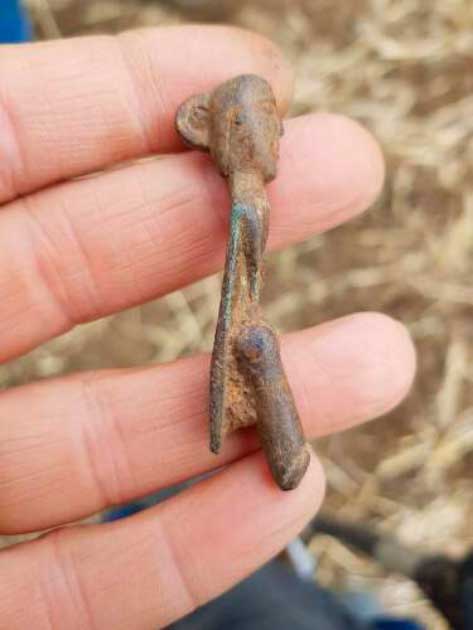
For Sale In Britain: A Small Ancient Man With A Colossal Penis
While metal detecting in a field, a British couple thought they found an ancient cart wheel piece, but it turned out to be a small human figure with a large bronze, hinged penis.
Noonans auction house will soon sell a small bronze statue featuring a man holding a large penis in his right hand, in Mayfair, London. The piece is expected to sell for between £800-1,200 ($1,440). It was discovered in 2022 by Paul Shepheard and his wife Joanne during a metal detector rally in Haconby, Lincolnshire.
I’ll See Your Penny, And Raise You This Little Fellah
According to Noonans, Joanne had just unearthed a medieval penny and Paul was scanning his XP Deus II detector, which cost twice as much as the artifact is expected to sell for, when he picked up a strong signal. Digging about 25.4 centimetres (10 inches) deep, Paul uncovered what he initially believed to be a large steel split pin, that was used in the Celtic/Romano world to secure wooden wheels on farm carts.
But after Paul had wiped away the mud from the object, a tiny human face peered back at him. And while the nude bronze man himself is small, in his right hand he is endowed with an oversized, hinged penis.
- The Journey of Napoleon’s Penis: Here’s the Long and the Short of It
- Roman Penis Pendant Found in Britain Declared a “National Treasure”

Celtic/Romano Bronze nude figure, c 1st century AD (Noonans)
A Little Guy Packing A Big Punch
The statue measures 5.1 centimeters (2 inches) tall, and is believed to date back to the 1st century AD. At this time Britain was populated by Celtic tribes who were being invaded by the legions of Rome. Nigel Mills, a consultant of coins and artifacts at Noonans, said about the object that there is "nothing quite like it,” and he speculates that it might have been used as a buckle to hold a sword's scabbard.
Mills thinks the statue's hinged phallus perhaps represented “good luck,” and that it might have been imbued with magical powers to “ward off evil spirits.” And so far as the man himself is concerned, Mills said he is “a fertility idol based on the Roman god Mercury.” While the first part of this assessment is accurate, in that the object most probably a “fertility idol,” the idea that it is “based on the Roman god Mercury,” is without foundation.
- Eight Surprising Things You Should Know About the Celts
- Fighting in the Buff: Did Celtic Warriors Really Go to War Naked?
One Thing, Is Not All Things
When archaeologists in Europe come across phallic artifacts they most often interpret them as “most probably for good luck, or to ward off evil spirits.” This is because Roman’s believed in a malignant force called the “oculus malus,” or Evil Eye, which was associated with bad luck and negative outcomes. However, no evidence has been presented to support the idea that the recently discovered statue, with its oversized hinged penis, has anything to do with the Roman god Mercury, whatsoever.
Long before the Romans invaded Britain in the 1st century, Celtic tribes practiced a complex agricultural and religious system in which the phallus was a central symbol. Associated with male virility and fertility, the carrying and wearing of oversized phallic symbols was thought to have promoted fertility in females and abundant harvests in fields. Scholars Miranda Green and James MacKillop noted that the Celts depicted their forest god “Cernunnos” wearing antlers, “with a prominent phallus,” as is seen, for example, on the Gundestrup Cauldron.

Paul Shepheard and his wife Joanne came across the statue when out metal detecting in Lincolnshire. (Noonans)
De-Romancifying Great Britain
The trouble here, as in many similar discoveries made in Britain, is that Celtic beliefs and practices were not written down. This means most of what is known comes from Roman and Greek accounts that are known to be biased, most often presenting pre-Roman cultures as barbarians. This lack of data about the Celtic world often causes archaeologists to settle for Roman interpretations of ancient symbols. But this is a failing, and it only serves to shadow the ancient lost pantheons of the pre-Roman world.
In this instance, Paul Shepheard, the finder and staff at Noonan's auctions, initially believed that the statue represented the Roman god Mercury. But later, after failing to find any other symbols of the Roman messenger deity, it was determined that this decorative scabbard buckle was worn by a Celtic man. In an “Insider” article Paul Shepheard concluded that “it was designed by the Celts,” who artistically added a hinged element “making their feelings even more obvious".
Based on this conclusion, the bronze statue most probably represents a person, perhaps the wearer, who associated with Cernunnos, the powerful fertility deity of Celtic religion that was worshipped as the “lord of wild things,” with an oversized penis.
Top image: Various photos of the statue of a man holding a large phallus. Source: Noonans
By Ashley Cowie














